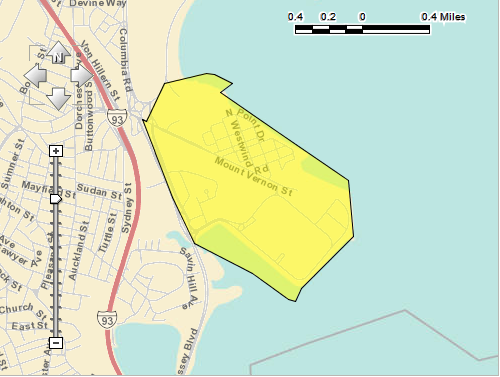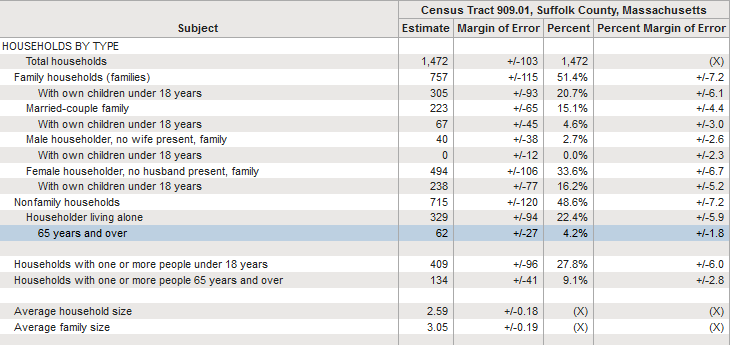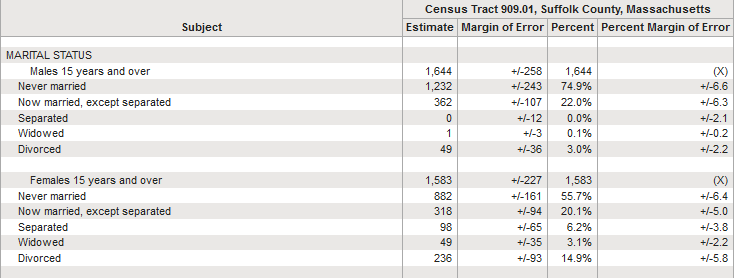Introduction
A census is typified by systematic procedures that are utilized to acquire and record information about members of a population. In most cases, censuses are conducted on a regular basis to understand some important attributes in society. It is critical to note that they are conducted on populations, housing, traffic, and businesses. Census information is commonly applied in research, marketing, and sampling surveys. This report is based on socio-economics, and it provides the census information that was obtained from census.gov.
Body





Ten interesting characteristics
After the four tables were reviewed, the following 10 characteristics were selected due to the fact they reveal an interesting profile about Suffolk County, Massachusetts:
- Family households
- Married-couple family
- Nonfamily households
- Female householder (no husband present)
- Child
- Nonrelatives
- Unmarried partner
- Males 15 years and over
- Females 15 years and over
- Unmarried women
A household involves persons who live together. It may be a single family or other groups of individuals. From a total number of 1,472 households, it is clear that the percentage of families is 51.4%. This is an interesting attribute of the population being described because it suggests the importance of family households to individuals. People could be influenced to live as families by several factors, such security.
Although many (51.4%) households are characterized by families, only a small fraction 1(5.1%) involves married-couple families. Thus, it can be asserted that most people in the families do not consider being in marriages, which could be a worrying trend due to the fact that only a few of the married-couples (4.6%) have children under 18 years. This could have a negative impact on the area because, at some point in the future, the level of available labor will significantly reduce.
Nonfamily households in the area constitute 27.8% of the population. It is interesting to learn that about most of the nonfamily households represent householders who live with other persons (87.6%). It is important to learn that most of the old people (65 years and over) do not live in nonfamily households. Thus, it would imply that many of the elderly are living with persons who can take care for them.
The number of female householders is about 33.6% in the population. Although the females are not supported by husbands, as a result of death, separation and/or divorce, they work to sustain their families. Furthermore, it is indicated that some families (16.2%) of the females have children who are under 18 years, but it is worrying that most of them do not have young children (83.8%).
With regard to relationships in the area being analyzed, it is prudent to state there is a good proportion of children (23.1%) compared with other members in the households. The children could be daughters, sons, nieces, nephews, and orphans. In fact, the number of children indicates that adults are interested in taking care for them.
It is clear that householders consider taking care for persons who are not related to them. The number of nonrelatives in relationships constitutes 20.9% of the population. Another important aspect to note is the insignificant difference between the number of children and nonrelatives in the area.
In this context, the number of unmarried partners in relationships is not significant (0.9%). Therefore, it is clear that people associate marriages with stable relationships. Otherwise, a large number of unmarried partners in relationships could indicate that many people could be in relationships that do not lead to marriages.
With regard to males 15 years and over, it is clear that the most of them have never married (74%), and none of those married has ever separated from his spouse. However, those widowed and divorced represent 0.1% and 3% respectively. The figures indicate that many married males prefer divorcing rather than separating from their partners.
It is interesting to learn that many females 15 years and over have never married (55.7%). In this context, those widowed and divorced represent 3.1% and 14.9% of the population.
In relation to fertility in this area, most of the females who are fertile are not married (80.6%). Thus, it is worrying that women in the reproductive ages are not married, and they are less likely to consider having children in the future.
Conclusion
From the tables and the ten characteristics analyzed in this report, it is vital to assert that the population is exemplified by interesting socio-economic attributes. They could have either negative or positive impacts on society, depending on different perspectives.